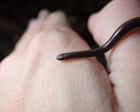
In a remarkable testament to nature’s resilience, the world’s smallest snake, the Barbados threadsnake, has been rediscovered on the island of Barbados after being unseen for two decades. Fears that this diminutive species, which grows to just 10 centimeters in length and is as slender as a strand of spaghetti, might have been lost to extinction have now been allayed. The discovery was made during an ecological survey conducted by the Barbados environment ministry and the conservation organization Re:wild, offering a glimmer of hope for those dedicated to the study and preservation of wildlife.
The rediscovery of this elusive creature under a rock at the center of the island brings to light the importance of ongoing ecological surveys and the role they play in understanding biodiversity in fragile ecosystems. This small but significant find highlights the interconnectedness of species and the delicate balance of the natural world, prompting renewed interest in the island’s unique ecological community.
While the return of the Barbados threadsnake underscores the vitality of species previously thought to be extinct, other institutions face challenges of a different kind. The Freud Museum in London, housed in the last residence of the famed psychoanalyst Sigmund Freud and his daughter Anna Freud, finds itself under scrutiny. Concerned writers and academics have urged a formal inquiry into allegations of bullying and misconduct against the museum’s board. These issues, allegedly stemming from political interference and autocratic decision-making, threaten to overshadow the museum’s mission of preserving and promoting the Freudian legacy.
Meanwhile, in the world of art, another discovery has captured attention. A painting attributed to Josefa d’Óbidos, a revered Portuguese Baroque artist, has been found to bear her signature. “Menino Jesus em descanso,” housed in the Palácio Nacional de Mafra, is the only work by d’Óbidos in the palace collection. This finding not only enhances the painting’s historical value but also enriches appreciation for the artistic contributions of women during a period when their work often went unrecognized.
Artistic and culinary worlds alike are experiencing rejuvenation. The publishing industry has seen a surge in interest and production of cookbooks, reflecting society’s evolving palate. The global fascination with food culture, amplified by the popularity of reality TV cooking shows and social media, has contributed to a vibrant market for culinary literature. These books invite readers to explore the intricacies of gastronomy, offering a tangible connection between chefs and the many layers of their creations.
Together, these stories weave a narrative of discovery and cultural enrichment across various fields. From the revival of a tiny snake species to the exploration of new artistic and intellectual pursuits, each tale adds its unique thread to the broader tapestry of human and ecological life. As we delve into these stories, they remind us of the enduring strength, diversity, and creativity that surround us, encouraging ongoing engagement with the vibrant world in which we live.
Source: {link}
